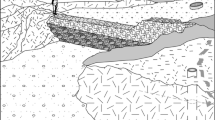Abstract
In the Mediterranean coastal regions a vast amount of the winter precipitation remains unutilized. Therefore it is necessary to take strong measures to make this unused water available to agriculture and drinking-water supply during the summer months. A suitable step to prevent the loss of fresh-water is the construction of an impervious, subsurface diaphragm this engineering project, it will be possible to utilize the winter-time precipitation for enrichment of the fresh-water aquifers.
In order to assess the suitability of a site for the proposed construction, preliminary reconnaissance of the site involving topographical, hydrogeological and geological investigations is necessary. It is an important prerequisite for successful and economic construction of the suggested diaphragm. Suitable conditions are given if the aquifer in question has an adequate storage capacity and if the distance between aquifer and aquiclude is relatively small.
As a result of the diaphragm-construction the aquifer benefits by increasing the potential of ground-water storage. This means a higher amount of fresh-water available for agricultural irrigation projects, ect. Moreover the diaphragm prevents the intrusion of salinewater. Loam, bentonite and ferroconcrete can be used as construction materials. A project of the kind mentioned above constructed near Lamia in Greece has increased the amount of abstractable fresh-water by about 80 per cent.
Résumé
Dans les teritories situés à la cote de la mer méditeranée, beaucoup des précipitations durant l'hiver restent inutilisées. Pour cete raison il faut qu'on prend des mesures suffisantes et qu'on essaye de faire disponsible cette eau inutilisée pour l'agriculture et pour le ravivitaillement d'eau potable. Un pas convenable pour éviter la perte d'eau douce est la construction d'un diaphragme souterrain et imper-méable, comparable avec une digue. La réalisations de ce projet géotechnique, fera possible d'untiliser les précipitation durant l'hiver pour l'enrichissement d'eau douce.
La qualification d'une région pour la construction proposées demande la connaissance du région, les instructions préliminmaires topographiques, hydréologiques et géologiques. C'est une condition importantes pour la construction du diaphragme, qui doit avoir du succés et doit être économique. Des coditions favorables sount par example quand l'aquifer en question a une capacité de gisement suffisante et quand en outre la distance entre l'aquifer et l'aquiclude est rélativement courte.
A cause de la construction du diaphragme l'aquifer profite du potential de la nappe d'eau souterraine de gisement. C'est important pour une plus grande élévation d'eau douce, utilisable pour des projects d'irrigation agronomiques etc. L'argile, le bentonit et le béton armé peuvent être utilisés comme matériaux de construction. Une esquisse montrera comment se développer le procès de cette construction. Un project susmentionné construit près de Lamia/la Grèce a mené à une augmentation d'eau douce de 80%.
Similar content being viewed by others
Author information
Authors and Affiliations
Rights and permissions
About this article
Cite this article
Garagunis, C.N. Construction of an impervious diaphragm for improvement of a subsurface water-reservoir and simultaneous protection from migrating salt water. Bulletin of the International Association of Engineering Geology 24, 169–172 (1981). https://doi.org/10.1007/BF02595269
Published:
Issue Date:
DOI: https://doi.org/10.1007/BF02595269




